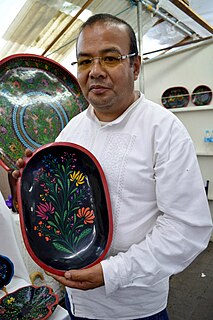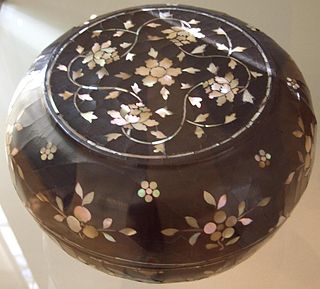 W
WLacquerware are objects decoratively covered with lacquer. Lacquerware includes small or large containers, tableware, a variety of small objects carried by people, and larger objects such as furniture and even coffins painted with lacquer. Before lacquering, the surface is sometimes painted with pictures, inlaid with shell and other materials, or carved. The lacquer can be dusted with gold or silver and given further decorative treatments.
 W
WChannapatna toys are a particular form of wooden toys and dolls that are manufactured in the town of Channapatna in the Ramanagara district of Karnataka state, India. This traditional craft is protected as a geographical indication (GI) under the World Trade Organization, administered by the Government of Karnataka. As a result of the popularity of these toys, Channapatna is known as Gombegala Ooru (toy-town) of Karnataka. Traditionally, the work involved lacquering the wood of the Wrightia tinctoria tree, colloquially called Aale mara (ivory-wood).
 W
WGluta usitata, previously known as Melanorrhoea usitata is an Asian tree species in the family Anacardiaceae. It may be known as Burmese lacquer, theetsee, thitsi or ringas.
 W
WJapanning is a type of finish that originated as a European imitation of East Asian lacquerwork. It was first used on furniture, but was later much used on small items in metal. The word originated in the 17th century. American work, with the exception of the carriage and early automobile industries, is more often called toleware.
 W
WLacquer painting is a form of painting with lacquer which was practised in East Asia for decoration on lacquerware, and found its way to Europe and the Western World both via Persia and the Middle East and by direct contact with Continental Asia. The artistic form was revived and developed as a distinct genre of fine art painting by Vietnamese artists in the 1930s; the genre is known in Vietnamese as "sơn mài."
 W
WLai rot nam or gilded black lacquer is a technique in the traditional Thai decorative arts consisting of the application of black lacquer with gold inlay to surfaces. It was used in the decoration of wooden furniture, especially cabinets, as well as door and window panels, in palaces and Buddhist temples. The art form developed during the Ayutthaya period, reaching its zenith during the seventeenth to early eighteenth centuries, and continued during the Thonburi and Rattanakosin periods.
 W
WMexican lacquerware is one of the country's oldest crafts, having independent origins from Asian lacquerware. In the pre-Hispanic period, a greasy substance from the aje larvae and/or oil from the chia seed were mixed with powdered minerals to create protective coatings and decorative designs. During this period, the process was almost always applied to dried gourds, especially to make the cups that Mesoamerican nobility drank chocolate from. After the Conquest, the Spanish had indigenous craftsmen apply the technique to European style furniture and other items, changing the decorative motifs and color schemes, but the process and materials remained mostly the same. In the 19th and 20th centuries, the craft waned during armed conflicts and returned, both times with changes to the decorative styles and especially in the 20th century, to production techniques. Today, workshops creating these works are limited to Olinalá, Temalacatzingo and Acapetlahuaya in the state of Guerrero, Uruapan and Pátzcuaro in Michoacán and Chiapa de Corzo in Chiapas.
 W
WLacquer is a type of hard and potentially shiny coating or finish applied to materials such as wood or metal. The term originates from the Sanskrit word lākshā (लाक्षा), representing the number one hundred thousand (100,000), which was used for both the lac insect and the scarlet resinous secretion, rich in shellac that it produces, used as wood finish in ancient India and neighbouring areas.
 W
WIn French interior design, vernis Martin is a type of japanning or imitation lacquer named after the 18th century French Martin brothers: Guillaume, Etienne-Simon, Robert and Julien. They ran a leading factory from between about 1730 and 1770, and were vernisseurs du roi. But they did not invent the process, nor were they the only producers, nor does the term cover a single formula or technique. It imitated Chinese lacquer and European subjects, and was applied to a wide variety of items, from furniture to coaches. It is said to have been made by heating oil and copal and then adding Venetian turpentine.